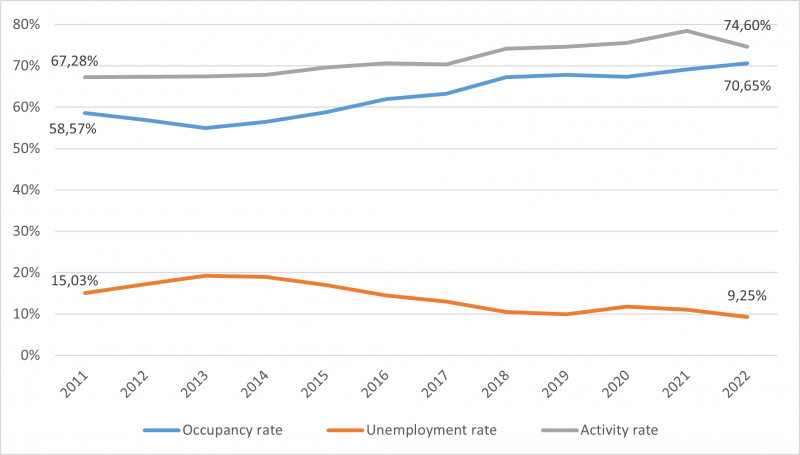
Introduction
The Municipality of Becerreá is located in the region of Ancares, in the southeast of the province of Lugo and 44 kilometres from the provincial capital. It is a territory that in 2022 had 2,755 inhabitants, with a surface area of 172.05 square kilometres. It has a degree of urbanisation of sparsely populated area, according to the Galician Institute of Statistics.
It is part of the Montes e Vales Orientais Rural Development Group (RDG3).

Population and demographic structure
The population of Becerreá showed a continuous decrease in the period from 1991 to 2022 of more than 1,370 inhabitants, with a figure of -33%. In the last ten years it continues to show a slight fall, albeit less pronounced, of -10.3%.
The demographic decline in Becerreá coincided with a change in the age distribution, which led to a gradual ageing of its population, with a large and continuous loss of working age population.
The age group most affected by the loss of population is the adult age group, between 16 and 64 years of age, with a reduction of 26%.
Demographic ageing is reflected in a narrowing at the bottom of the population pyramid and a thickening at the top, as well as an increase in the median age. The average age of the inhabitants in 2022 was closed to 53.5 years, with the same average age for both women and men.
The increase of the Total Dependency Ratio (TDR) in Becerreá registered 82% in 2022, above the Galician and provincial index for the same year, after a continuous increase since 2009. The index remained stable in Becerreá until 2004, when it fell to the lowest value of the period analysed, 68%, and then increased until 2022.

Population dynamics in Becerreá.

Evolution of the total dependency ratio of Becerreá, Lugo and Galicia.
Economy
The evolution of Gross Disposable Product (GDP) in Becerreá alternated negative and positive growth rates throughout the 2010s, with the exception of the period 2014 to 2016, where it decreased by 2.8%, while Galicia and Lugo maintained a positive trend. Between 2018 and 2020, GDP contracted at three territorial levels, registering a decline of only 0.7% in Becerreá, an amount lower than the reductions observed in Galicia, with -7.7%, and Lugo, with -7.2%. In 2020, the municipal GDP is close to 48.66 million euros.
The Gross Disposable Income (GDI) shows an evolution of growth. In 2002 and 2006 it increased by 19.6% to 15,000 euros per inhabitant. After 2014, it showed a downward trend and ends up reaching 14,300 euros in 2020. However, over the whole period 2002-2020, municipal revenues grown by 14.8%, in line with a 10% increased in revenues in rural municipalities and more than 6.7% in urban growth.
Using the register of social security affiliations as an estimate of municipal employment, Becerreá experienced a 1% reduction between 2011 and 2022. Analysed by sector, the primary sector hast lost 27.5% of affiliates, a reduction similar to, and even higher than, that experienced in Galicia and other localities in Lugo. The secondary sector is also experiencing a reduction in non-municipal affiliations, as is the case in Lugo, which has lost two affiliates in both cases by around 12%, while in Galicia they only fall by 3%. On the other hand, the tertiary sector is gaining weight with an increase in the number of affiliates of 13% in Becerreá, a figure that is in line with the increase observed without together in Galicia, with 14%, and without together in Lugo, with 9.6%.
In 2022, Becerreá had an activity rate of 74.6%. The employment rate was 71% in 2022. The unemployment rate was 9.3%. A brief analysis of the labour market in Becerreá points to a relatively favourable evolution in the municipality, characterised by a slight decrease in the active and employed population, but a greater decrease in the unemployed population.

Evolution of Gross Disposable Income per inhabitant in Becerreá, Lugo and Galicia.

Evolution of employment, unemployment, and activity rates in the municipality of Becerreá.
Energy resources
Becerreá has a modest energy infrastructure based on renewable sources, namely solar photovoltaic and hydraulic energy. The installed capacity of photovoltaic solar energy is 20 kilowatts. It also has approximately 282 kilowatts of installed hydraulic power. However, diversification of renewable energy sources is essential to strengthen the municipality’s energy resilience and maximise its economic potential. The expansion of other forms of renewable energy, such as wind or biomass, would not only help to reduce dependence on a single source, but could also generate new economic and employment opportunities in the area.
The electricity consumption of Becerreá in 2023 was estimated at 5,754.57 MWh. Residential consumption was 3,239.87 MWh. The consumption of services, including municipal services, was 2,304.92 MWh. Industry consumed 209.78 MWh.
Energy Policy Councils
Date of the first meeting:
12th April 2024
Number of participants:
2 people
Profile of participants:
- Staff of the municipality of Becerreá: mayor
- EC4RURAL project staff: UVIGO, ESPAZOCOOP
- Citizens
Evaluation of the energy situation
The deputy mayor of Becerreá pointed out that the EC4RURAL project will lead to direct savings in energy costs. It is confirmed that there is space for the photovoltaic installation, but the problem is that the council has neither the staff nor the budget to carry it out without an economic subsidy.
Dialogue between the parties
During the meeting, there was an open dialogue between the citizens and the municipality about photovoltaic energy production, although it was brief due to the low attendance.
Conclusions
It is mentioned that there are difficulties in taking the community initiative forward. This was due to insufficient involvement of the municipality and lack of motivation without the participation of the municipality. As a result, the Energy Policy Council was not established.


